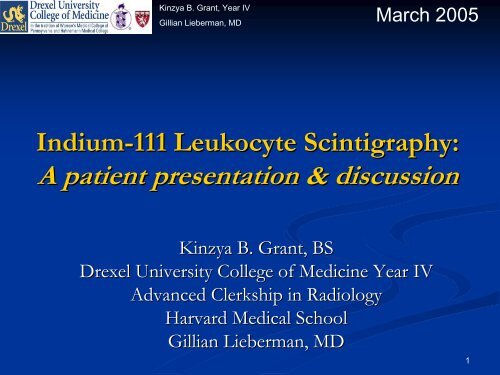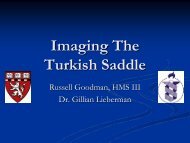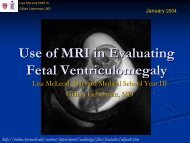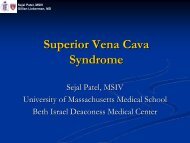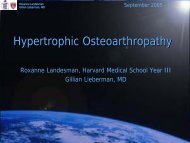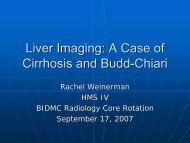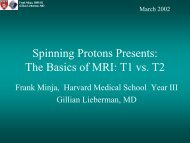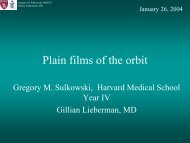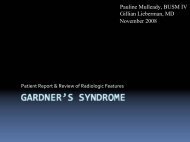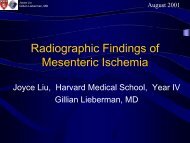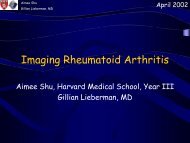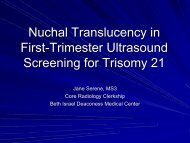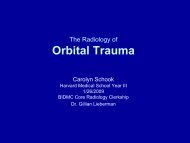Indium-111 Leukocyte Scintigraphy - Lieberman's eRadiology ...
Indium-111 Leukocyte Scintigraphy - Lieberman's eRadiology ...
Indium-111 Leukocyte Scintigraphy - Lieberman's eRadiology ...
You also want an ePaper? Increase the reach of your titles
YUMPU automatically turns print PDFs into web optimized ePapers that Google loves.
Kinzya B. Grant, Year IV<br />
Gillian Lieberman, MD<br />
March 2005<br />
<strong>Indium</strong>-<strong>111</strong> <strong>Indium</strong> <strong>111</strong> <strong>Leukocyte</strong> <strong>Scintigraphy</strong>:<br />
<strong>Scintigraphy</strong><br />
A A patient patient presentation & & discussion<br />
Kinzya<br />
B. Grant, BS<br />
Drexel University College of Medicine Year IV<br />
Advanced Clerkship in Radiology<br />
Harvard Medical School<br />
Gillian Lieberman, MD<br />
1
Kinzya B. Grant, Year IV<br />
Gillian Lieberman, MD<br />
Overview<br />
Patient Presentation<br />
Background Information on Nuclear Medicine<br />
<strong>Scintigraphy</strong><br />
Differential Diagnosis<br />
Menu of Tests<br />
Discussion of Our Patient<br />
2
61yo male<br />
Recent history<br />
Kinzya B. Grant, Year IV<br />
Gillian Lieberman, MD<br />
Our patient is a…<br />
persistent fever of unknown origin<br />
Reason for referral<br />
evaluation for source of infection<br />
Type of procedure<br />
<strong>Indium</strong>-<strong>111</strong> <strong>Indium</strong> <strong>111</strong> oxine-labeled oxine labeled leukocyte scintigraphy<br />
This study is done as outpatient procedure<br />
3
Kinzya B. Grant, Year IV<br />
Gillian Lieberman, MD<br />
Let Let us us begin begin with with some some background<br />
information.<br />
4
Kinzya B. Grant, Year IV<br />
Gillian Lieberman, MD<br />
Nuclear Medicine Background Information<br />
What is In-<strong>111</strong> In <strong>111</strong> oxine-labeled oxine labeled leukocyte scintigraphy? scintigraphy<br />
A diagnostic imaging test that displays radiolabeled<br />
white blood cells in the body<br />
What is <strong>Indium</strong>-<strong>111</strong>? <strong>Indium</strong> <strong>111</strong>?<br />
A group III element that decays by electron capture<br />
emitting 2 gamma photons of 173keV and 247 keV<br />
Physical half-life half life of 67 hrs<br />
5
Kinzya B. Grant, Year IV<br />
Gillian Lieberman, MD<br />
Nuclear Medicine Background Information<br />
What is oxine? oxine<br />
Oxine (8-hydroxyquinolone) (8 hydroxyquinolone) is a lipid-soluble lipid soluble complex that<br />
chelates metal ions<br />
<strong>Leukocyte</strong>s are removed from plasma for labeling<br />
How is it taken up?<br />
<strong>Indium</strong>-<strong>111</strong> <strong>Indium</strong> <strong>111</strong> oxine complex diffuses through cell membranes<br />
Once intracellular, the complex dissociates<br />
<strong>Indium</strong>-<strong>111</strong> <strong>Indium</strong> <strong>111</strong> binds nuclear and cytoplasmic proteins<br />
Oxine diffuses back out of the cell<br />
6
Kinzya B. Grant, Year IV<br />
Gillian Lieberman, MD<br />
Nuclear Medicine Background Information<br />
How are <strong>Indium</strong>-<strong>111</strong> <strong>Indium</strong> <strong>111</strong> oxine-labeled oxine labeled leukocytes<br />
distributed?<br />
After infusion, radiolabeled leukocytes are<br />
distributed to the blood pool, lungs, liver, and spleen<br />
Imaging is done 18-24 18 24 hrs after injection when lung<br />
and blood pool activity are not normally seen<br />
7
Kinzya B. Grant, Year IV<br />
Gillian Lieberman, MD<br />
Nuclear Medicine Background Information<br />
Why do we use it?<br />
To obtain scintigrams of specific anatomic regions<br />
for suspected infection and/or inflammation<br />
8
Kinzya B. Grant, Year IV<br />
Gillian Lieberman, MD<br />
There There are are many many indications for for the the<br />
use use of of this this radiopharmaceutical.<br />
9
Kinzya B. Grant, Year IV<br />
Gillian Lieberman, MD<br />
Applications of <strong>111</strong>-<strong>Indium</strong> <strong>111</strong> <strong>Indium</strong> <strong>Scintigraphy</strong><br />
Detect sites of infection/inflammation in pts with FUO<br />
Localize unknown source of sepsis & detect additional<br />
site(s) site(s)<br />
on infection in pts with persistent or recurrent<br />
fever and known infection site<br />
Survey for site of abscess or infection in febrile post-op post op<br />
pt without localizing signs & symptoms<br />
Palestro<br />
et al, Society of nuclear medicine procedure guideline for indium indium-<strong>111</strong><br />
<strong>111</strong> leukocyte scintigraphy<br />
for suspected<br />
infection/inflammation. Version 3.0 2004<br />
10
Kinzya B. Grant, Year IV<br />
Gillian Lieberman, MD<br />
More More appropriate indications for for the the<br />
use use of of <strong>Indium</strong>--<strong>111</strong> <strong>Indium</strong> <strong>111</strong> radiolabeled<br />
scintigraphy in in other other types types of of<br />
patients..<br />
patients<br />
11
Kinzya B. Grant, Year IV<br />
Gillian Lieberman, MD<br />
Applications of <strong>111</strong>-<strong>Indium</strong> <strong>111</strong> <strong>Indium</strong> <strong>Scintigraphy</strong><br />
Detect site(s) site(s)<br />
and extent of IBD<br />
Tc-99m Tc 99m labeled leukocytes may be preferable<br />
Detect and follow up osteomyelitis when in cases of…<br />
Joint prostheses, nonunited fractures, or sites of metallic<br />
hardware from prior bone surgery<br />
Detect osteomyelitis in diabetic pts when…<br />
Degenerative or traumatic changes, neuropathic<br />
osteoarthropathy, osteoarthropathy,<br />
or prior osteomyelitis<br />
Palestro<br />
et al, Society of nuclear medicine procedure guideline for indium indium-<strong>111</strong><br />
<strong>111</strong> leukocyte scintigraphy<br />
for suspected<br />
infection/inflammation. Version 3.0 2004<br />
12
Kinzya B. Grant, Year IV<br />
Gillian Lieberman, MD<br />
And…<br />
And…<br />
13
Kinzya B. Grant, Year IV<br />
Gillian Lieberman, MD<br />
Applications of <strong>111</strong>-<strong>Indium</strong> <strong>111</strong> <strong>Indium</strong> <strong>Scintigraphy</strong><br />
Detect osteomyelitis in skull in post-op post op pts and<br />
for follow up of therapy<br />
Detect mycotic aneurysms, vascular graft<br />
infections, and shunt infections<br />
Palestro<br />
et al, Society of nuclear medicine procedure guideline for indium indium-<strong>111</strong><br />
<strong>111</strong> leukocyte scintigraphy<br />
for<br />
suspected infection/inflammation. Version 3.0 2004<br />
14
Kinzya B. Grant, Year IV<br />
Gillian Lieberman, MD<br />
Additional Background information<br />
In the case of Osteomyelitis:<br />
Osteomyelitis<br />
To detect abnormal bone remodeling<br />
Three phase bone scan may be used in conjunction with<br />
leukocyte scintigraphy<br />
and<br />
To assess marrow distribution at suspected<br />
osteomyelitis sites<br />
Tc-99m Tc 99m sulfur colloid is a useful adjunct<br />
15
Kinzya B. Grant, Year IV<br />
Gillian Lieberman, MD<br />
Additional Background information<br />
Other useful nuclear medicine studies<br />
Gallium scintigraphy<br />
Preferred in patients with neutropenia<br />
Or nonsuppurative or lymphocyte-mediated lymphocyte mediated infections<br />
Tc-99m Tc 99m HMPAO (exametazime<br />
( exametazime)-labeled labeled leukocyte<br />
scintigraphy<br />
Frequently used option for acute infections, particularly in<br />
pediatric patients<br />
16
Kinzya B. Grant, Year IV<br />
Gillian Lieberman, MD<br />
Additional Background information<br />
What type of scintigrams can we produce?<br />
Regional<br />
Whole-body Whole body<br />
Planar<br />
and/or Single Photon Emission Computed<br />
Tomography (SPECT)<br />
17
Kinzya B. Grant, Year IV<br />
Gillian Lieberman, MD<br />
Now Now Back Back to to Our Our Patient<br />
Patient<br />
18
Kinzya B. Grant, Year IV<br />
Gillian Lieberman, MD<br />
Our Patient’s WBC Study<br />
Injection of autologous white blood cells labeled<br />
with <strong>Indium</strong>-<strong>111</strong> <strong>Indium</strong> <strong>111</strong><br />
Images of whole body obtained at 24 hours<br />
Additional SPECT images of chest<br />
Confirm findings<br />
19
Kinzya B. Grant, Year IV<br />
Gillian Lieberman, MD<br />
Our patient’s whole-body whole body image<br />
Normal liver uptake<br />
Abnormal uptake<br />
Normal spleen uptake<br />
PACS, BIDMC<br />
20
sternum<br />
Kinzya B. Grant, Year IV<br />
Gillian Lieberman, MD<br />
Chest frontal view<br />
Left shoulder region<br />
PACS, BIDMC<br />
Normal spleen uptake<br />
21
Kinzya B. Grant, Year IV<br />
Gillian Lieberman, MD<br />
Chest “repro” sagittal view<br />
This image was<br />
reformatted<br />
from SPECT<br />
Thoracic<br />
vertebral<br />
column<br />
PACS, BIDMC<br />
22
Kinzya B. Grant, Year IV<br />
Gillian Lieberman, MD<br />
Our Patient’s WBC Study Findings<br />
Marked increased activity in region of L<br />
shoulder<br />
Smaller foci of activity<br />
Superior aspect of sternum at R sternoclavicular<br />
joint<br />
Within mid thoracic vertebral column<br />
23
Kinzya B. Grant, Year IV<br />
Gillian Lieberman, MD<br />
Interpretation Criteria<br />
Normal Findings<br />
18-24 18 24 hr: liver, liver,<br />
spleen, spleen,<br />
bone marrow, marrow,<br />
minimal activity in<br />
major blood vessels<br />
4 hr: diffuse pulmonary activity<br />
Abscess Detection<br />
1/3 to ½ sites visualized by 4hr, >90% by 24 hr<br />
Osteomyelitis<br />
Focal accumulation > adjacent background activity<br />
&<br />
Corresponds to bone site of increased bone<br />
radiopharmaceutical accumulation<br />
24
Kinzya B. Grant, Year IV<br />
Gillian Lieberman, MD<br />
Interpretation of Patient’s study<br />
Above findings are consistent with multiple<br />
sources of inflammation in<br />
L shoulder<br />
Sternum<br />
Thoracic spine<br />
Review of recent plain films of L shoulder<br />
No significant abnormality<br />
25
1.<br />
2.<br />
Kinzya B. Grant, Year IV<br />
Gillian Lieberman, MD<br />
Differential Diagnosis<br />
Marked focus of activity within L shoulder<br />
Infectious process: septic joint or septic bursitis<br />
Osteomyelitis of L humerus or scapula cannot be<br />
excluded<br />
Additional foci of activity within the sternum<br />
and mid thoracic spine<br />
Multifocal infectious process: osteomyelitis or<br />
diskitis<br />
26
Kinzya B. Grant, Year IV<br />
Gillian Lieberman, MD<br />
Menu of tests for further imaging<br />
Conventional Radiography<br />
Scintigraphic Techniques<br />
bone scan, gallium, labeled leukocytes, newer agents<br />
Cross-Section Cross Section Imaging<br />
US<br />
CT<br />
MRI<br />
27
Travels to ED<br />
Kinzya B. Grant, Year IV<br />
Gillian Lieberman, MD<br />
Our Patient’s Course<br />
Receives antibiotic treatment<br />
Receives acetaminophen<br />
Shoulder joint aspiration<br />
Followed by Hospital Admission<br />
28
HPI<br />
Kinzya B. Grant, Year IV<br />
Gillian Lieberman, MD<br />
On Admission<br />
2 months of fevers to 104F, weight loss, L shoulder pain<br />
1-2 2 weeks drenching night sweats<br />
Outpatient: + tagged WBC scan, negative TTE, ESR 130<br />
PMH<br />
HTN<br />
ETOH abuse – quit 1 month ago<br />
Hypercholesterolemia<br />
Depression<br />
Pancreatitis 4 yrs ago<br />
29
PE<br />
Kinzya B. Grant, Year IV<br />
Gillian Lieberman, MD<br />
On Admission<br />
VS: 99.7 107-125 107 125 133/86 24 95%RA<br />
+ temporal wasting<br />
Sternal mass<br />
No occipital, no axillary, axillary,<br />
no auricular, no epitrochlear LAD<br />
Shoulder erythema, erythema,<br />
hot, indurated, indurated,<br />
pain with active/passive<br />
movement, decreased ROM<br />
Lab results<br />
ESR 130 CRP 12.56<br />
Joint Fluid: WBC 130,500 97% PMNs<br />
30
Imaging<br />
Kinzya B. Grant, Year IV<br />
Gillian Lieberman, MD<br />
On Admission<br />
L shoulder 3 views (AP, neutral, ax)<br />
No fracture or osseous destructive change<br />
Equivocal superior subluxation of humeral head within<br />
glenoid fossa<br />
Acromioclavicular joint space narrowed with degenerative<br />
changes noted<br />
Chest (PA & lat)<br />
No interval change compared to previous exam 9 days<br />
prior<br />
31
Axial view<br />
of shoulder<br />
Kinzya B. Grant, Year IV<br />
Gillian Lieberman, MD<br />
Our Patient’s CT of upper limb with<br />
large field of view on HD #2<br />
Humeral<br />
head<br />
PACS, BIDMC<br />
small<br />
glenohumeral<br />
joint effusion<br />
To assess for osteomyelitis<br />
32
CT shoulder coronal<br />
Kinzya B. Grant, Year IV<br />
Gillian Lieberman, MD<br />
Our Patient’s CT of upper limb with<br />
Glenoid fossa<br />
large field of view on HD #2<br />
Reformatted image<br />
clavicle<br />
acromion<br />
Head of humerus<br />
Note fluid density surrounding the joint<br />
PACS, BIDMC<br />
Can you appreciate the distended<br />
subacromial/ subdeltoid and subscapularis<br />
bursae?<br />
33
Kinzya B. Grant, Year IV<br />
Gillian Lieberman, MD<br />
Our Patient’s CT of upper limb with<br />
Bone windows<br />
large field of view on HD #2<br />
R sternal clavicular joint fragmentation<br />
PACS, BIDMC<br />
34
Kinzya B. Grant, Year IV<br />
Gillian Lieberman, MD<br />
Our Patient’s CT of upper limb with<br />
Soft tissues<br />
large field of view on HD #2<br />
Small foci of calcifications<br />
PACS, BIDMC<br />
35
Coronal STIR<br />
Kinzya B. Grant, Year IV<br />
Gillian Lieberman, MD<br />
Our Patient’s MRI of<br />
Chest/Mediastinum<br />
Chest/ Mediastinum<br />
PACS, BIDMC<br />
on HD #2<br />
High intensity<br />
noted<br />
surrounding<br />
joint on STIR<br />
Reason:<br />
Soft tissue mass<br />
versus joint fluid<br />
collection<br />
36
Kinzya B. Grant, Year IV<br />
Gillian Lieberman, MD<br />
Our Patient’s MRI of<br />
Chest/Mediastinum<br />
Chest/ Mediastinum<br />
Coronal STIR PACS, BIDMC<br />
on HD #2<br />
Just another coronal<br />
STIR image<br />
37
Kinzya B. Grant, Year IV<br />
Gillian Lieberman, MD<br />
Our Patient’s MRI of<br />
Chest/Mediastinum<br />
Chest/ Mediastinum<br />
A Coronal T2-weighted image<br />
PACS, BIDMC<br />
on HD #2<br />
Notice the asymmetry of<br />
the joints.<br />
38
Axial STIR<br />
Kinzya B. Grant, Year IV<br />
Gillian Lieberman, MD<br />
Our Patient’s MRI of<br />
Chest/Mediastinum<br />
Chest/ Mediastinum<br />
PACS, BIDMC<br />
on HD #2<br />
There is motion artifact.<br />
Again, we can<br />
appreciate the<br />
asymmetry and the<br />
peripheral enhancement<br />
of the distended bursa<br />
on the left with effusion.<br />
39
Kinzya B. Grant, Year IV<br />
Gillian Lieberman, MD<br />
Our Patient’s MRI of<br />
Chest/Mediastinum<br />
Chest/ Mediastinum<br />
Axial T2 weighted image<br />
PACS, BIDMC<br />
on HD #2<br />
Another view of<br />
high intensity<br />
signal<br />
surrounding the<br />
shoulder<br />
40
Kinzya B. Grant, Year IV<br />
Gillian Lieberman, MD<br />
Our Patient’s MRI of<br />
Chest/Mediastinum<br />
Chest/ Mediastinum<br />
Post contrast axial T1 weighted image with<br />
fat saturation<br />
PACS, BIDMC<br />
on HD #2<br />
Final axial MRI<br />
image depicting the<br />
joint effusion<br />
41
Kinzya B. Grant, Year IV<br />
Gillian Lieberman, MD<br />
Our Patient’s Course<br />
Surgical Procedures on HD #2<br />
Arthrosopic L shoulder irrigation & debridement<br />
and subacromial bursa irrigation & debridement<br />
Incision & drainage of the R sternal clavicular joint<br />
42
Kinzya B. Grant, Year IV<br />
Gillian Lieberman, MD<br />
Our Patient’s Course<br />
Surgical Procedures on HD #5<br />
Open irrigation & debridement of L glenohumeral<br />
joint and subacromial bursa<br />
Irrigation & debridement of R sternoclavicular joint<br />
incision with VAC dressing placement<br />
43
Kinzya B. Grant, Year IV<br />
Gillian Lieberman, MD<br />
Our Patient’s Course<br />
Our Patient remained febrile.<br />
Recall the positive radiolabeled white blood cell<br />
scan in the thoracic region…<br />
44
Kinzya B. Grant, Year IV<br />
Gillian Lieberman, MD<br />
Our Patient’s MRI of entire spine on<br />
T2 image of spine<br />
HD #5<br />
Evaluation for abscess or<br />
other evidence of infection.<br />
Can you find the lesion?<br />
PACS, BIDMC<br />
Osteomyelitis<br />
on T2 weighted<br />
image:<br />
Increased<br />
signal intensity<br />
45
Osteomyelitis<br />
on T1<br />
weighted<br />
image: low<br />
medullary<br />
signal<br />
intensity<br />
Kinzya B. Grant, Year IV<br />
Gillian Lieberman, MD<br />
Our Patient’s MRI of<br />
Chest/Mediastinum<br />
Chest/ Mediastinum<br />
T1 pre contrast T1 post contrast<br />
PACS, BIDMC<br />
Gadolinium<br />
enhancement<br />
of T7-8 lesion<br />
on HD #2<br />
46
STIR<br />
Kinzya B. Grant, Year IV<br />
Gillian Lieberman, MD<br />
Our Patient’s MRI of<br />
Chest/Mediastinum<br />
Chest/ Mediastinum<br />
PACS, BIDMC<br />
on HD #2<br />
Osteomyelitis of spine spreads<br />
regionally via anastomosing venous<br />
channels to involve at least 2 adjacent<br />
vertebral bodies and intervening disc.<br />
This lesion is pathognomic.<br />
Thoracic region<br />
abnormal signal at<br />
T7 & T8 and in the<br />
intervening disc<br />
space consistent<br />
with discitis and<br />
osteomyelitis<br />
47
Kinzya B. Grant, Year IV<br />
Gillian Lieberman, MD<br />
Summary of Hospital Course<br />
Admitted<br />
Joint aspiration & antibiotics<br />
OR: irrigation & debridement by orthopedics<br />
OR: manubrium and R 1 st rib removed, VAC device placed by thoracics<br />
Post-op Post op compl. compl.<br />
R pneumothorax => chest tube placement<br />
Post-op Post op compl. compl.<br />
Persistent R pleural effusion<br />
Significant delirium, elective intubation<br />
OR repeat debridement shoulder & sternum for continued fevers<br />
Sternal debridement grew coag neg staph and group B strep<br />
Presumed endocarditis => TEE neg<br />
Other areas: MRA brain, brain,<br />
LP, bronchoscopy,<br />
bronchoscopy,<br />
abdominal CT<br />
MRI spine – diskitis and osteomyelitis prolonged antibiotics<br />
Pt improving<br />
Fever => blood, urine, urine/serum eosinophils r/o drug fever<br />
48
Kinzya B. Grant, Year IV<br />
Gillian Lieberman, MD<br />
Patient Summary<br />
61yo male with PMH of ETOH abuse,<br />
pancreatitis, and hypercholesterolemia<br />
presented with fevers/NS/wt loss and L shoulder<br />
pain/sternal pain/ sternal mass<br />
found to have<br />
L septic shoulder<br />
manubrium/R<br />
manubrium/R<br />
sternoclavicular joint osteomyelitis<br />
T7-8 T7 8 thoracic spine diskitis/osteomyelitis<br />
Negative blood cultures, negative TEE, negative LP,<br />
normal MRA brain<br />
49
Kinzya B. Grant, Year IV<br />
Gillian Lieberman, MD<br />
Summary of Patient Presentation<br />
Although radiolabeled<br />
scintigraphy<br />
does not show bony<br />
detail or distinguish osteomyelitis<br />
from soft tissue<br />
infections, nuclear medicine imaging can detect<br />
osteomyelitis<br />
10-14 10 14 days before changes are visible on<br />
plain radiograph.<br />
Our patient greatly benefited from <strong>Indium</strong>-<strong>111</strong> <strong>Indium</strong> <strong>111</strong><br />
oxine<br />
labeled leukocyte scintigraphy<br />
in this case<br />
of fever of unknown origin.<br />
50
Kinzya B. Grant, Year IV<br />
Gillian Lieberman, MD<br />
Our Patient’s Plan<br />
Continue antibiotics for at least 6 weeks<br />
&<br />
Repeat MRI of spine in 2 months and follow up<br />
with an appointment.<br />
51
Kinzya B. Grant, Year IV<br />
Gillian Lieberman, MD<br />
References<br />
Palestro CJ, Brown ML, Frostrom LA, McAfee JG, Royal HD, Schauwecker DS,<br />
Seabold JE, Signore A. Society of nuclear medicine procedure guideline for indium- indium<br />
<strong>111</strong> leukocyte scintigraphy for suspected infection/inflammation. Version 3.0 2004:1- 2004:1<br />
6.<br />
Becker W, Meller J. The role of nuclear medicine in infection and inflammation. The<br />
Lancet 2001; 1:326-33. 1:326 33.<br />
Turpin S, Lambert R. Imaging of musculoskeletal and spinal infections: infections:<br />
Role of<br />
scintigraphy in musculoskeletal and spinal infections. Radiol Clin N Amer 3:2, 2001.<br />
Tehranzadeh J, Wong E, Wang F, Sadighpour M. Imaging of musculoskeletal and<br />
spinal infections: Imaging of osteomyelitis in the mature skeleton. Radiol Clin N Amer<br />
3:2, 2001.<br />
Thrall JH, Ziessman HA. Nuclear medicine: the requisites, 2001.<br />
Paluska SA. Osteomyelitis.<br />
Osteomyelitis.<br />
Clin Fam Prac 6:1, 2004.<br />
Kjaer A, Lebech AM. Diagnostic value of (<strong>111</strong>)In-granulocyte<br />
(<strong>111</strong>)In granulocyte scintigraphy in patients<br />
with fever of unknown origin. J Nucl Med 2002;43(2):140-4. 2002;43(2):140 4. Abstract<br />
52
Kinzya B. Grant, Year IV<br />
Gillian Lieberman, MD<br />
Acknowledgements<br />
Maryellen Sun, MD<br />
Nicole Nelson, MD<br />
Jesse Wei, MD<br />
J Anthony Parker, MD, PhD<br />
Kevin Donohoe, Donohoe,<br />
MD<br />
Gerald Kolodny, MD<br />
Gillian Lieberman, MD<br />
Pamela Lepkowski<br />
Larry Barbaras<br />
53


